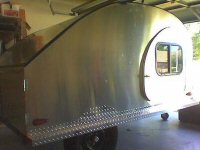Yellow Jackets... Did I do the right thing?
23 posts
• Page 1 of 2 • 1, 2
Yellow Jackets... Did I do the right thing?
Discovered a yellow jacket nest under the roof overhang on the fire station. They built it right over a flood light and completely encased it... The nest was the size of a watermellon.
I thought about calling a pest guy or someone who comes and gets them to use for medical purposes, which probably woulda been the smart thing to do but...
Since I live in a fire station, you see...
I have mega water pressure, so I blasted the thing away with the garden hose.
I "pressure" washed the thing away so there is no sign of the nest whatsoever, but the yellow jackets are still there, buzzing around like crazy, even as darkness is falling
Question...
If I keep blasting the former nest site with water every so often, will they go away or try to re-establish the nest???
I thought about calling a pest guy or someone who comes and gets them to use for medical purposes, which probably woulda been the smart thing to do but...
Since I live in a fire station, you see...
I have mega water pressure, so I blasted the thing away with the garden hose.
I "pressure" washed the thing away so there is no sign of the nest whatsoever, but the yellow jackets are still there, buzzing around like crazy, even as darkness is falling
Question...
If I keep blasting the former nest site with water every so often, will they go away or try to re-establish the nest???
-

Dean in Eureka, CA - The Fogcrawler
- Posts: 4997
- Images: 69
- Joined: Thu May 11, 2006 8:44 pm
Dean in the future....give the local kids sticks and tell them it's a Pinata!!! 
 Hey everyone...it's just a joke, do not do this at home, it should only be done by professionals in a controlled environment!!! Or with kids that really really bug you! Doug
Hey everyone...it's just a joke, do not do this at home, it should only be done by professionals in a controlled environment!!! Or with kids that really really bug you! Doug

 Hey everyone...it's just a joke, do not do this at home, it should only be done by professionals in a controlled environment!!! Or with kids that really really bug you! Doug
Hey everyone...it's just a joke, do not do this at home, it should only be done by professionals in a controlled environment!!! Or with kids that really really bug you! Doug- doug hodder
- *Snoop Dougie Doug
- Posts: 12625
- Images: 562
- Joined: Tue Dec 14, 2004 11:20 pm






 Well since you didn't kill the Yellow Jackets you might want to move the nest (CAREFULLY) to somewhere else. They might decide to stay in the bush and guard the nest. Next time they hear water you could be in for a fight.
Well since you didn't kill the Yellow Jackets you might want to move the nest (CAREFULLY) to somewhere else. They might decide to stay in the bush and guard the nest. Next time they hear water you could be in for a fight. 



